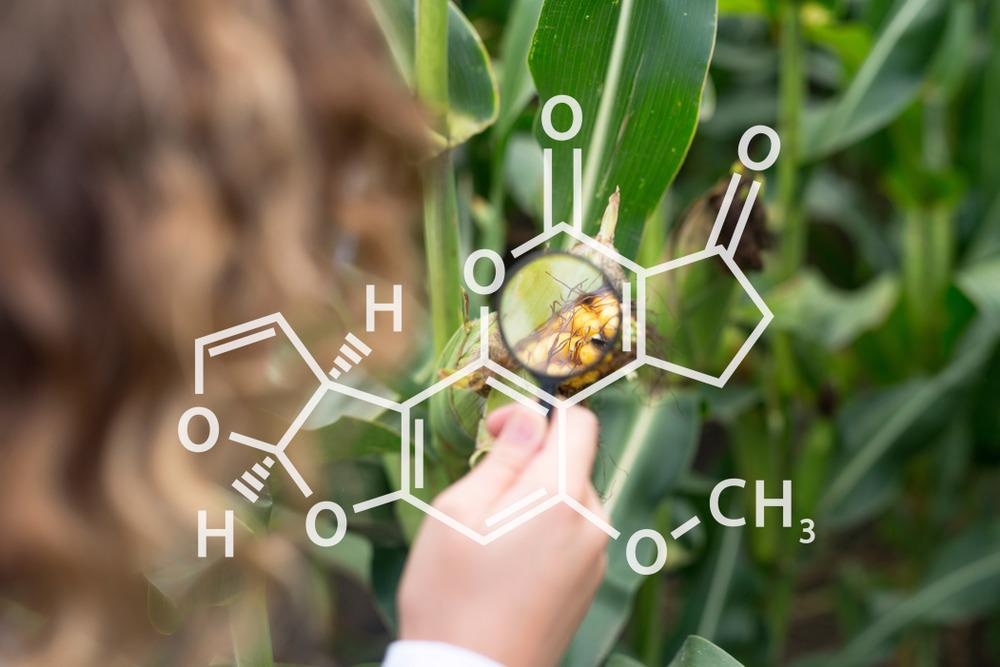In their latest article published in Food Chemistry, researchers developed a unique and reliable electrochemiluminescence immunoassay (ECLIA) for the extremely sensitive and highly selective measurement of aflatoxin B1 (AFB1) in food samples.

Study: Self-enhanced electrochemiluminescence of luminol induced by palladium–graphene oxide for ultrasensitive detection of aflatoxin B1 in food samples. Image Credit: Aleksandar Malivuk/Shutterstock.com
What are Aflatoxins?
Aflatoxins (AFs) are poisonous organic molecules generated by the fungus Aspergillus flavus, Aspergillus nomius, and Aspergillus parasiticus; these fungi thrive in a variety of foods and oats, posing a severe danger to food standards. Aflatoxin B1 (AFB1) is the most dangerous of these toxins, with high carcinogenic potential. In humans and animals, AFB1 intake can result in liver malignancy, colon cancers, and breast cancer. The maximum allowable concentration of AFB1 in nuts and seed commodities is 20 μ g kg-1.
Conventional Detection Processes
Standard chromatography-based approaches for AFB1 measurement include high-performance liquid chromatography (HPLC), thin-layer chromatographic measurements, and liquid chromatography-tandem mass spectroscopy. Although these technologies have high selectivity, they need considerable sample preparation and have high running costs, limiting their widespread applicability.
Currently, the enzyme-linked immunosorbent assay (ELISA) has sparked considerable interest due to its ease of use and low cost; yet its durability and productivity remain unsatisfactory for extensive industrial use. As a result, a novel technique for dynamic and highly sensitive detection of AFB1 is still required.
An Introduction to Electrochemiluminescence (ECL)
Electrochemiluminescence (ECL) has evolved as a potent method that is extensively employed in the food industry especially in the food hygiene department in past few years; such an experimental apparatus has piqued the interest of researchers due to its low radiated power, sensitivity, selectivity, and simple construction.
Luminol is used in several ECL devices for cellular monitoring since it is non-toxic, affordable, and has a high luminescence efficiency. It is generally known that adding co-reactants to luminol ECL, such as H2O2, can considerably boost the system's luminescence performance. Although these luminol–H2O2 systems exhibit vivid ECL, their reliance on unstable H2O2 prevents them from being used in biological sensing. As a result, establishing a successful ECL program based on luminol that does not require H2O2 remains a serious difficulty.
In-Luminol Dissolved Oxygen Systems and Their Limitations
Dissolved oxygen has lately been utilized in the form of non-toxic reactants resulting in the development of reactive oxygen species (ROS) by a reaction of oxygen with luminol free radicals to augment ECL transmissions. The species obtained as a product include super-oxygen reactive oxygen species, monoline oxygen, and hydroxyl free radicals. However, the intrinsic low sensitivity of dissolved oxygen has a substantial impact on its use as a supplementary oxidant in the detection of minor compounds.
As a result, in luminol–dissolved oxygen devices, a chemical that stimulates dispersed oxygen processes is required to create more ROS and improve the ECL signal. So far, numerous nanostructures, including metal-based oxides, have been employed to speed up the generation of ROS from dissolved oxygen and to enhance the oxidizing of luminol to boost its ECL output.
In the latest study, a new and ultrasensitive ECLIA for AFB1 monitoring was created using a lum–Pd–GO complex's self-enhanced ECL.
Research Findings
The results indicated that mixing the GO solution and K2PdCl4 aqueous solution at 30 °C for 60 minutes produced the best ECL signal. It was discovered that the hybrid made by combining 0.5 mL of 0.2 mg mL-1 Pd–GO and 5 mL of 0.01 mmol L-1 luminol had the highest ECL intensity.
The ECSAs of the Pd–GO and lum–Pd–GO GCEs were 0.115 cm-2 and 0.103 cm-2, respectively, indicating that luminol alteration had little effect on the ECSA of Pd–GO. Higher ECSAs suggest that more adsorption sites are accessible for electrocatalysis, which would improve luminol's ECL.
The ECL signal was greater in the lum–GO/CS GCE than in the lum/CS GCE, indicating that GO enhanced the electrodes with molecular luminol. Surprisingly, the lum–Pd–GO/CS GCE produced ECL intensities that were approximately 8.5- and 4-fold higher than those produced by the lum/CS GCE and lum–GO/CS GCE, respectively. SEM pictures of 3D NGH and 3D NGH–AuNPs indicated that 3D NGH has homogeneous GO layers and a significant porous structure. It was discovered that the ECL amplitude reached its peak at a pH of 7.4.
These results would not only encourage more research into self-enhanced ECL materials but would also give a better foundation for on-site exact detection of AFB1.
Reference
Xia, Mengke, et al. (2022) Self-enhanced electrochemiluminescence of luminol induced by palladium–graphene oxide for ultrasensitive detection of aflatoxin B1 in food samples. Food Chemistry 381. 132276. Available at: https://www.sciencedirect.com/science/article/pii/S0308814622002370?via%3Dihub
Disclaimer: The views expressed here are those of the author expressed in their private capacity and do not necessarily represent the views of AZoM.com Limited T/A AZoNetwork the owner and operator of this website. This disclaimer forms part of the Terms and conditions of use of this website.